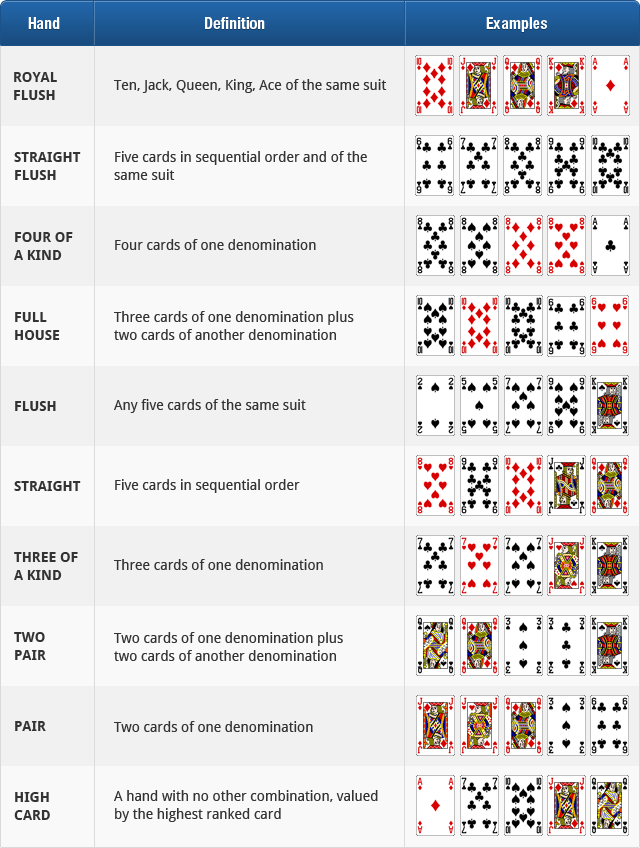Rules of No Limit Texas Hold’em
It’s easy. It’s fun. Making money takes no time.
We are talking about No Limit Texas Hold’em. We are talking about the most popular and available form of poker.
Once you know the rules and start dragging some pots, it’s off to the races.
What Is the Goal, How Do I Play?
No Limit Texas Hold’em is as easy to learn as it is exciting to play. Adding chips to your stack is the name of the game. To add chips to our stack we must win pots.
The goal is to win pots. There are two ways to do that…
- Value Bet – We can have the best hand and “value bet.” This means we bet and get called by a worse hand, thus winning the pot. We are simply “trying to get value” from a lesser hand.
- Bluffing – We can bluff! Bluffing means betting in order to make a better hand fold. We bluff when we don’t have a good hand, but we do not believe our opponent does either. Bluffing can be effective but it is risky. The easiest way to win at poker is simply to make the best 5 card hand possible.
What Is the Best 5 Card Hand?
This chart below illustrates the hand rankings from top to bottom in Texas Hold’em.

What is the Difference Between a Tournament and a Cash Game?
Tournament
In a tournament, we buy-in and receive a starting stack of chips. An example would be a $500 buy-in, where every player starts with 10,000 chips. We play until a winner is declared. Payout structures vary with most tournaments paying out between 10-15% of the total field.
If there are 100 entrants, around 10th-15th place would be a min-cash. Min cashes are generally double the buy in but again can vary depending on where we are playing. A typical tournament win pays the winner around 20% of the total prize pool. These numbers will certainly differ between tournament venues so be sure to know the payout structure before you sit down.
Cash Games
While the goals of cash games (winning pots and adding chips to our stack) remain the same, the structure is different. We don’t have to play until we either bust out or win. We can sit down at the table and leave the table as we wish. If we double our money in 30 minutes and want to leave we are free to do so.
In cash games, the blinds (a term we will define in a moment) remain constant. In a $2-$5 no-limit game, the small blind will always stay at $2 and the big blind will stay at $5.
In tournaments, the blinds increase every level in order to keep the tournament moving along. Levels in live tournaments generally last 40 minutes, but again will be different at unique events. Generally the longer the levels last the “better the structure is considered.” The WSOP main event levels last 2 hours.
Who Am I Competing Against?
When we play poker we are playing against the other players at the table. This is not blackjack or slots.
The house does not care if we win or lose. They make money by the players paying a rake.
What Is a Rake?
Rake is essentially “the juice” the casino charges the player to play. In tournaments, this is the “forced fee” that is withdrawn from each entry of the prize pool. Most casinos charge around 12-15 percent as the rake.
That means if we play a tournament with a $500 buy-in, typically about $425 goes into the prize pool and the additional $75 will be used for equipment and paying the dealers.
In a cash game the rake is taken in one of two ways. Most cash games just take a percentage of every single pot. This is generally 5-10 percent of the pot and is usually capped at $5. In larger no limit cash games, generally $5-$10 and up: they do what is known as “timed pot”. Every 30 minutes the dealer collects $7 from each player. In timed pots, no money is ever taken out of a pot.
General Setup of The Table
How Many Players Play at a Table?
Live at the casino, full-ring, or 9-handed is the most common way you will see No Limit Texas Hold’em being played.
When playing online, 6-max (6-handed), as well as heads-up vs. a single opponent, are generally available as well. Either way, the rules and goals remain the same.
- Community Cards
- The community cards are the five cards that each player can combine with their two cards to make the best five-card hand possible. The first three cards are known as the “flop.” The 4th card is the “turn.” The 5th card is the “river.” These cards and how the betting works will be explained in great detail in a section below.
- Dealer Button
- The button is the player to the right of the blinds and will be the final player to act each betting round. This is widely considered as the “best position” to play our hand from.
- Small Blind
- The small blind is the player in between the button and big blind. This player must post a fixed amount of chips into the pot before the cards are dealt. If we are playing a tournament with the blinds at 200-400, the small blind is responsible for placing out 200 chips before the hand starts. In a $2-$5 cash game, the small blind is the player posting $2. The small blind will act first on all betting rounds.
- Big Blind
- The big blind is the player to the left of the small blind. If we are playing a tournament with the blinds at 200-400, the big blind is responsible for placing out 400 chips before the hand starts. In a $2-$5 cash game, the small blind is the player posting $5. If no player raises before the flop, the big blind may check his or her option and see the flop without committing any additional chips.
To keep everything fair, all three of these positions rotate in a clockwise fashion following each hand. Everyone will experience the button and the blinds equally.
How Does a Hand Play Out?
Let’s make this even more fun and easy to follow. We will describe the action of a hand just like it would play out at the table. Poker is played in “streets” or betting rounds. It all starts before the flop….
Preflop
Everyone is dealt two cards. The player to the left of the big blind is up first. That player can either fold their two cards, call the big blind, or open for a raise of any amount. (We will later cover Limit Hold’em where the betting amount is a fixed amount).
Calling means matching the amount of whatever the current bet is. If nobody has raised, calling would be the amount of the big blind. If someone has opened for a raise, we can no longer call the big blind. We must match the amount of the raise. The other option is to re-raise…
Re-raising, commonly referred to as “3-betting” can become frequent in aggressive games. No limit means exactly that. There is no limit to the amount of chips or number of times the pot can be re-raised.
Here is an example of a 3-bet in a cash game. We are playing $2-$5 no limit and there is a raise to $20. Let’s say we don’t want to fold and we don’t want to call the $20. To apply pressure we can “3-bet” or re-raise the pot to whatever we want. Common 3bets in cash games are 3-4 times the size of the original raise. In this case, a 3-bet to $60 or $80 can come in handy. If the original raise comes over the top of our re-raise and makes it $200; that is considered a “4-bet.” Another raise after that? A 5-bet. This can continue to go on until the players are all in.
Once each player has had a chance to act we go to the flop…
Flop
Let’s see if we connect with the board! The first card is “burned” or simply placed face down. This is a way to make sure the dealer is not cheating or colluding with a player at the table. In the past dealers unfortunately would cheat for certain players so the idea of a “burn card” helps prevent such things.
The next 3 cards off the top of the deck are placed face up on the table. These first 3 community cards are what is known as the flop. Everyone in the hand can use these cards (to make the best five-card hand possible).
This time, whoever is to the left of the button is the first player to act. He or she can either check or bet. Checking simply means passing the action to the next person.
We just pass the action on to the next player. Betting means putting more chips into the pot. Once a player bets, the next player can fold, call the bet, or raise the bet. Once a bet is made, checking is no longer an option until the next card comes….
Turn
The fourth card, or the turn card is now placed face up next to the flop. The order and rules for this betting round are identical as the flop. Whoever is left after this betting round gets to see the final card…
River
The fifth and final card is now placed face up next to the turn, completing the 5 community cards. The betting round takes place with the same rules as in earlier betting rounds. The difference here is what happens next.
If the river is checked, the hands are turned face up and the pot is awarded to the player with best 5 card hand. If a bet is made on the river and nobody calls, the pot is now over and awarded to whoever placed the bet.
If the bet is called, the winning hand takes the pot. Rules on this final exchange vary between tournaments and cash games and can even be different depending on which casino you are at. Those details will be covered in the section below.
Rule Differences/Be Aware
There are certain things that we need to be aware of before we sit down and play in a poker game. We always want to be aware of where we are playing and any “house rules” that may be different from our normal poker game. This is to protect us from losing out on a pot because of a silly rule we didn’t know about. Here are a few key points to always be aware of before sitting down to play…
Cash Games vs. Tournaments
Whether we are playing in a cash game or in a tournament, the rules of No Limit Texas Hold’em remain the same. There are however a few differences in how the action of a hand may take place. Let’s take a look at what we are talking about…
Player A bets out on the river and we call the bet. Player A says, “Nice call, you caught me bluffing” and throws the hand into the muck.
In a tournament the answer is yes, we must show our winning hand. This is done solely to protect the players and avoid collusion. In a cash game, however, we do not need to show our hand if the bettor mucks. If we call the river bet and the bettor does not turn his hand face up, we are awarded the pot.
Oversized Chip Rule
We are in a cash game and we bet $35 on the river. My opponent tosses in a $100 chip without saying anything.
This is just a call. The opponent must announce “raise” in order for the single $100 chip to be a raise. Otherwise, this is just a call.
I Didn’t Hear Him Say All-in!
We are playing a cash game and our opponent has $600. He pushes out a single $25 chip on the river and says “All-in”. As he is putting his bet out we quickly toss out $25, signifying a call. He turns his hand over and we rip our earphones off and say,
Do we have to call $25 or his all-in for $600?
We must call the full amount of $600 as it is our responsibility to know the correct action. Cash games or a tournament, it makes no difference. If a bet is made and the opponent tosses in a chip, he or she is responsible for the full amount.
Straddles
We will not see straddles in tournaments. In cash games, however, straddles are allowed in many casinos, but not all. A straddle is essentially a third blind. Straddles are NOT however blind raises.
If we are playing $2-$5 No limit, a straddle would be a $10 blind that must be put down before the cards are dealt from the player to the left of the big blind (next to act). This player is known as the under the gun, or UTG player. The difference between a blind raise and a straddle is the player who straddles will still have the option to act again before the flop.
Mississippi Straddles
Mississippi straddles have one major difference than a regular straddle and that is: which player straddles. Instead of the player to the left of the big blind (UTG player) placing the $10 straddle, it comes from the player on the button.
Some casinos begin the action with the player in the small blind, others still begin action with the player to the left of the big blind. Many casinos do not allow this form of straddling so be sure to check with the Poker room manager beforehand.
It is important to note that while generally a straddle is twice the amount as the big blind, in some cases it can be more. We have seen $2-$5 no limit games with the ability to straddle anywhere from $10-$50. These games are less common but certainly exist.
Limit Hold’em
Limit Hold’em is just like No Limit Texas Hold’em save for one major difference: the betting structure. In no limit, we know any player can wager their entire stack at any point in the hand. In limit hold’em the betting amounts are predetermined. Let’s say we are playing $4-$8 limit hold’em…
This means the “small bet is $4 and the big bet is $8.” The blinds would be $2-$4 because the big blind and small bet are always equal. Before the flop and on the flop we can only bet in $4 increments. On the turn and river we bet in increments of $8.
The amount of raises and re-raises in limit hold’em WILL depend on which casino you are at. Generally 4 or 5 raises is the most allowed. This means after 4 or 5 raises the action is considered “capped”, and the only option now is to call or fold.
Conclusion
The more we play No Limit Texas Hold’em, the more fun it becomes. There is a reason it is the most popular poker game being played.

